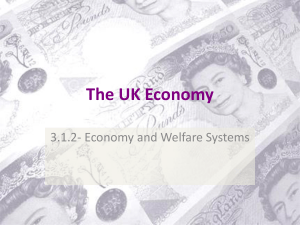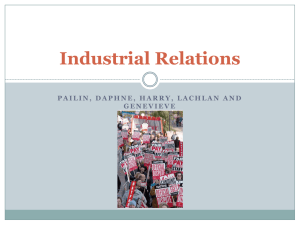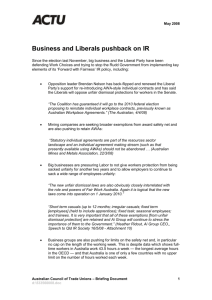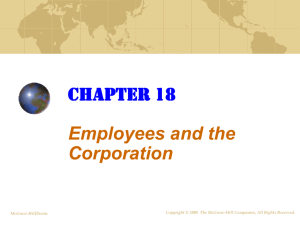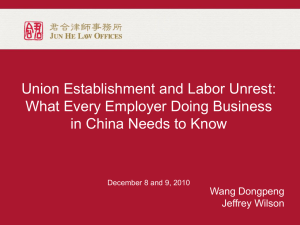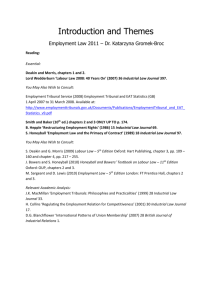Employee relations - willihighbusinessmanagementyear12
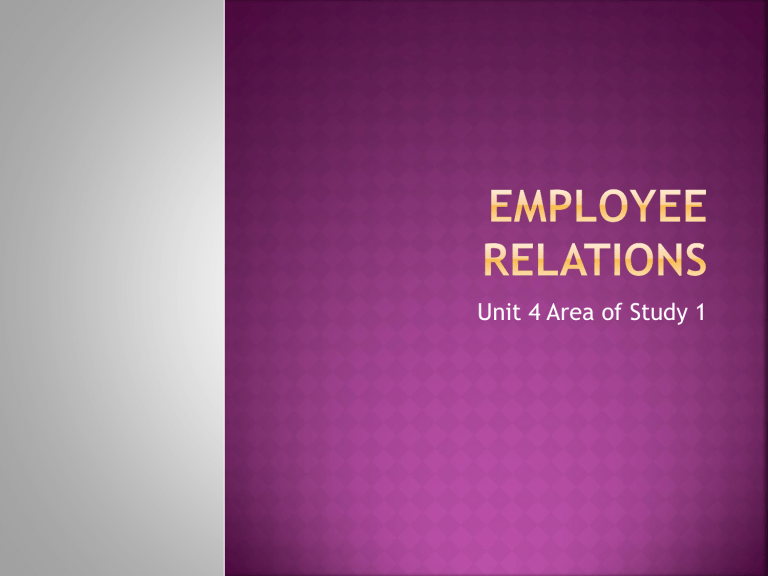
Unit 4 Area of Study 1
To achieve an optimum working relationship between employees and management
To focus on using specific strategies to retain, reward, and motivate effective and skilled employees
To create optimum worker and organisational productivity, which leads to increased business competitiveness
Effective management of ER:
► Leads to a harmonious work environment
► Allows for maximum workplace productivity
► Increases business competitiveness
► Decreases levels of conflict
► Promotes the concept of an organisational team
► To make sure employees are readily adaptable to change
Employee
Relations
Participants
1. Employees and Trade
Unions
2. Employers and employer unions
3.
Government
4. Fair Work
Australia
Employees work under a collective agreement, award or individual contract
Employees look to improve wages and conditions and flexibility in work practices
Trade Unions are an organisation formed to represent and protect the rights of workers in a particular industry
Unions provide a number of services to members in order to protect their rights
Employers try to negotiate workplace agreements at workplace
Employer associations represent and assist employer groups and promote their common interest in employee relations
Dual role – largest employer in Australia
As the government enacts legislation that directly controls and influences the conduct of employee relations in areas such as
Employee contracts
Taxation
Occupational Health and Safety
Equal opportunity
Pay and working conditions
Responsible for economic management which impacts on economic activity
Provides information, advice and assistance on workplace issues
Fair Work Australia: power to vary awards, make minimum wage orders, approve collective agreements, determine unfair dismissal claims
Fair Work Ombudsman: promotes legislative compliance, educates, informs and provides assistance, appoints Fair Work Inspectors
Fair Work Inspectors: assist employees and employers to comply with National Employment
Standards (NES), awards and collective agreements
Where awards (pay and working conditions) were determined by a central body (AIRC) relating to an industry
Conflict resolution used conciliation and arbitration
Awards were negotiated directly between employers and the AIRC and the unions representing workers
Considered to be centralised due to its reliance on one central body (the AIRC)
AIRC established industrial awards – minimum conditions of employment for employees doing a particular job
Advantages
Certainty of pay & working conditions in same industry
Tighter government control through centralised wage determination body
More opportunity for industrial action
Disadvantages
Reduces potential for employer/employee flexibility
Doesn’t recognise individual organisation’s circumstances
Potential for trade unions to have greater control
Employers – saves time & effort and refer to gov’t determined document to find out pay & working conditions
Wage outcome imposed, no trade-off for increased productivity
Unions have opportunity to mount harmful campaigns
Lessens the importance of participative management approach as wages aren’t negotiated at workplace
Where employers and employees at each workplace determine their pay and working conditions and work through their differences without outside interference
Workplace Relations Act 1996:
Collective/certified agreement – enterprise bargaining agreements which result from negotiations between an employer and union
Fair Work Act 2008: main aims to strengthen the safety net of minimum wages and conditions, abolishing AWAs and restoring collective bargaining as the main means of creating an agreement and restoring to all employees protection against unfair dismissal.
Advantages
Allows employers/employees to negotiate pay and working conditions relevant to the individual workplace
Employers have opportunity to negotiate productivity gains, employees negotiate increased flexibility in working arrangements
Creates more inclusive working environment as both parties are working together to achieve agreement
Disadvantages
Reduces level of government control in wage determination
More time-consuming for employers as they now need to undertake negotiations.
May feel some of employees’ demands are unrealistic.
Some workers may feel more vulnerable as influence of unions as representatives of workers is often reduced.
Passive resistance
Work to rule
Boycott
Stop work meeting
Picket line
Strike
Lockout
Protected industrial action - action that occurs during a protected period when a new collective agreement is being negotiated
Unprotected industrial action - industrial action taken outside the negotiating and bargaining process
Fair Work Australia has the power to suspend or terminate protected industrial action. Fair
Work Australia may also make orders to stop or prevent unprotected industrial action.
Such orders are enforceable in the courts
Role of the HRM greatly increased under decentralised approach. Must:
Negotiate with employees and/or their representatives on employment relations issues such as the establishment of collective agreements
Act as an intermediary between employees/unions and senior management
Should aim to facilitate positive, productive relationships with its employees
Should attend to employee complaints in such a way as they do not escalate
Commitment by management and employees to achieve organisational objectives (ie common purpose and teamwork)
Adopting participative and open management style
Treating employees and their complaints seriously
Promotion and acceptance that workplace change is inevitable and essential for business competitiveness
Effective communication skills and methods
Providing fair pay & working conditions
Recognition of employee achievements
Maintenance of good working relationships between management and unions
Establishment of fair and accessible grievance procedures for any possible disputes
Performance Indicators (workplace audit)
Level of employee participation in decision making (high)
Degree of consultation in workplace indicates level of worker empowerment
Communication channels (open)
Values – shared and positive
Productivity levels – demonstrate motivation and satisfaction. Links to profitability
Staff morale levels (high)
Incidence of industrial action
Rate of union membership



